During these times we think it is important to reflect on the vitality of our industry and the people who have built it.
Stephen McCarthy, graphic designer chats to Andy Watson, architect and both live in Christchurch.
During these times we think it is important to reflect on the vitality of our industry and the people who have built it.
Stephen McCarthy, graphic designer chats to Andy Watson, architect and both live in Christchurch.
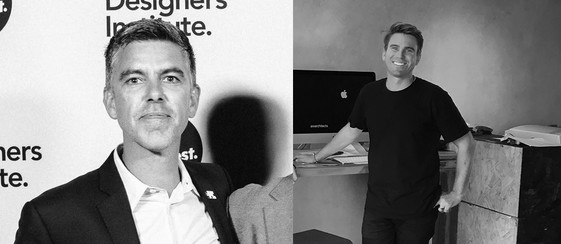
Stephen McCarthy & Andy Watson have a chat
1_Stephen to Andy:
People often talk about “collaboration” making creative work stronger but I find it a bit of a buzzword, as equally painful as “brainstorming” if it’s not done at the right time of the creative process.
Do you find any truth in this isolation actually helping come up with better creative ideas in your work?
Can you be more focused and free from the noise and opinions of others that are sometimes trying to be helpful but ultimately compromise a good idea at an early stage ?
Yip that’s pretty interesting. The idea of collaboration making creative work stronger at a conceptual stage does present challenges for me. There needs to be a clear conceptual vision and I don’t necessarily think that comes from a committee approach to the concept design. I think it’s harder to find the Big Idea if you’re rattling ideas around a group trying to pick one out.
That’s not to say that collaborating with other designers is bad. Not at all. Indeed we have great relationships with other designers; However, I feel it relies on their essentially being a creative director that is curating the shots as they’re fired as the project is kicking along, and that doesn’t need to be me! It just needs someone at the reigns. There is also the scale side of things.
As a small practice, we rely heavily on collaboration with like-minded designers to quickly generate creative muscle to deliver to larger clients. Bringing in a different mindset or set of skills to approach a particular design issue is a great way of expanding our horizons and not being ’siloed’.
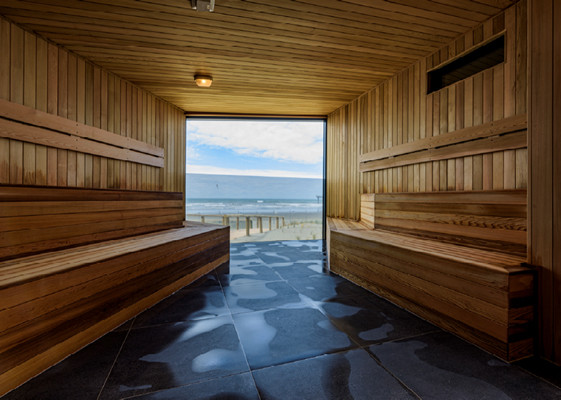
New Brighton Pools view from the sauna out to the ocean
In regards to the isolation question, it’s weird, I don’t feel like I’m getting particularly creative, or stimulated to be creative architecturally. It might be the fact that there’s so much else going on (home schooling!).
I like being in a creative environment (the studio) where there’s interactions and stimulus. I don’t think I’d make a good hermit. I have sown a lovely grassed area that I’m anticipating being partially creative on once it’s grown though, and am having a great time watching the grass grow!
I guess the other thing that may have curtailed isolation creativity is the general stress of trying to keep a small practice going through uncertain times. I've found the space and time have sparked creative outlets in other ways apart from the creating architecture. We have had time to really look at the business with some distance and review various parts of it, set goals, and think how we can exit this tighter as a design team and stronger as a business.
The space has been great for things like prepping and cooking dinner, and I’ve really been enjoying the whole process of foraging / bartering food around the neighbourhood, and having time to really cook a good tasty delicious meal.
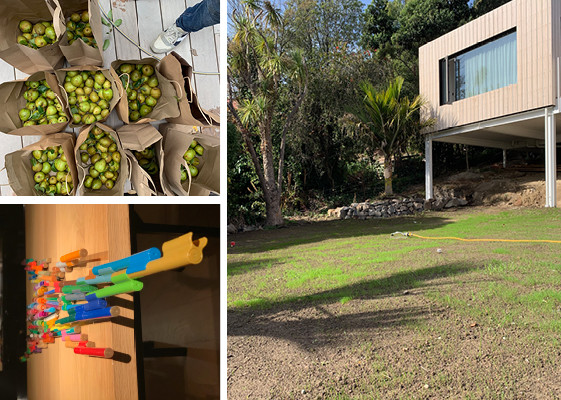
Foraging, kids creations and the newly seeded lawn
Going back to your question about ‘the noise and opinions of others’, it kind of goes back to the set up of my company. There’s a reason why it’s AW Architects and not a shared or common name. It means I can have direct authority over all aspects of the business, including design direction.
I certainly take all the advice I can get, and our team has design freedom; However, it's my name on the door, so ultimately I can veto something if I feel strongly about it, and I think design relies on the ability to be able to make gut instinct calls without being second guessed.
It also means my expense account doesn’t get questioned either!
2_Andy to Stephen
So you asked me about the collaboration buzzword. What’s your take on the ‘resilience’ buzzword? We’ve taken our respective studios through a few significant upheavals now, and have watched a city grow through various different stages of regeneration.
We’ve both been directly involved in different aspects of the rebuild and have a certain amount of creative capital invested in the success of the city.
Do you feel that your studio and team are particularly resilient compared to designers in other cities, and has the idea of resilience had an effect on your creative process?

Work for the Christchurch Arts Festival
I’m intrigued to the creative stuff you’re looking forward to doing on your lawn, kubb, naked sunbathing, walnut collecting?
Resilience - yes, it’s another one of those words that we’ve used a lot in Christchurch and I think the intent of words at first make sense but then they get overused and they become a little meaningless - or at least lose the true intent of the sentiment. I think the earthquake helped me personally and our business realise that things go in stages and phases.
I started McCarthy just before the first quake and at the time thought - well that was a crazy move - it’s all going to turn to crap now and I should become a potato farmer. I had two studios demolished with everything inside (including my fave 1960’s Rogers drum kit), one studio in each earthquake and we couldn’t get back in.
A week later, a group of business leaders got together and asked us to do a campaign called Love Christchurch (alongside a mate Tim Chesney of make Collective who I was working with at the time) and we developed a logo and brand that helped Cantabrians see that the Old Christchurch was still here - just a little battered and bruised.
I also did a small self-initiated project called retrace with Laura Griffiths and we documented all the buildings we lost in the quake to raise money for a heritage fund. Then we got asked to develop a well-being campaign for an initiative of the CDHB and The Mental health Foundation called All Right? to help tackle the pulse and mental health of the city.
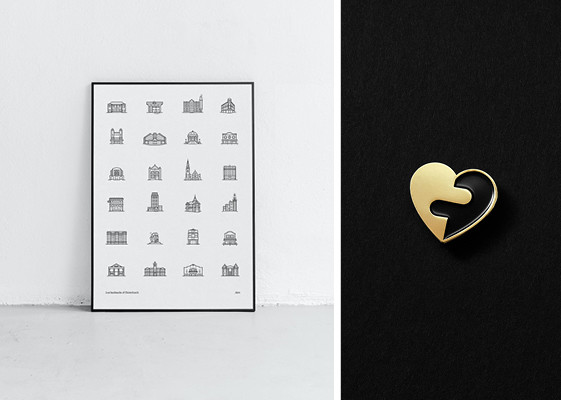
Retrace project and the Kotahitanga Pin.
They are still one of our main clients we work with today and very trusting, amazing bunch of people. - we’ve just completed a nationwide set of TV ads and social in response to Covid and it all started way back in the time of another disaster.
All those things have taught me a lot about creating design that actually can help people on a personal level and connect alongside the work we do that helps businesses and brands.
For me, I need both to make me feel creatively useful as a human. It taught me at times of crisis you have to move fast with your design thinking, trust your gut and just go for it. Sometimes in that process you can lose a little of the time you have to fully craft something in the usual manner you would and should with creating brand work for other clients so it’s a tricky compromise.
So I feel this time round in Christchurch we as a design community have the hindsight to go - oh well - here we go - another interesting predicament - we will get through, it will be different afterwards and you have to adapt and work out priorities to survive. These phases will pass and change and design can be a power to do good and help people and business thrive.
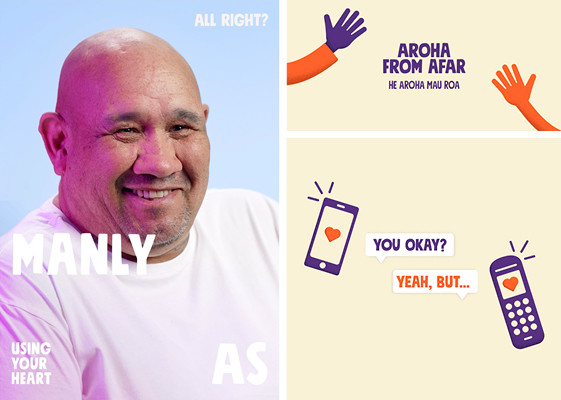
All Right? Campaign work
Back to overused phrases - when people say “enjoy” when they hand over coffee… I freakin hate that - or "have a safe trip”…. It’s not going to make a difference cause you said it. Wow - I do sound like a grumpy old hermit
Anyway, coffee…. Have your coffee making skills got better over this time? Mine are terrible and my wife bought some beans infused with strawberries… geez.
3_Stephen to Andy
So I know you cause you live about two blocks away, and have a love for the Stone Roses nearly as passionate as mine but would be cool to delve a little deeper. You used to be a designer right with your design studio Deflux who you part own too?
What kind of design did you do and what made you make the switch from design to Architecture?
What makes the ideal client and can you tell us about your most rewarding process and commission?
Yeah I like that concept of phases and stages. I remember as a younger adult, when things weren’t going well there would always be an inherent sense that ’this too will pass’ given the fullness of time.
So once you’ve seen a few phases you start looking around when things aren’t particularly instagrammable and seeing the little things that make you smile.
In part for me, that’s been watching the foot traffic increase in town as the rebuild grinds on, and palpably watching a city grow and regenerate. We’re lucky in that we set up the studio on St Asaph Street on the South Frame fringe, and the window to the north is basically a constantly changing vista as buildings go (to start) and come (now and into the future).
You’re right, I had a previous stint as a designer with Deflux, who are now also part of our shared workspace at the St Asaph Studio. It’s a bit of a long story as to the road to architecture via Deflux but I’ll give it a nudge!
After three years at Auckland School of Architecture, I decided it was time to get out of the institutional environment. To be honest, I cratered in my 3rd year just slipping by with a Bachelor of Architectural Studies. I’d done well the first two years, but by year three the focus had definitely shifted to not being at 8am lectures on Architectural theory. I left Auckland Dec ’96 to go snowboarding in Canada on a student work abroad Visa. In Canada (well, on the way but that’s another story), I met Jono Ross who was studying Vis Com in Christchurch. We hung out and rode Whitewater near Nelson, BC.
That’s where I picked up the Stone Roses CD and would crank that in various stages of delirium post epic Canadian powder days. I then moved to London for a couple of years and did everything except architecture. I was a cycle courier, a plumbing fitter on a larger construction site, I did some house painting etc, but lost touch with Jono over that time.
I arrived back in Christchurch in Dec 1999 for the millennium new year, and sometime in January 2000 I was very nearly run over by Jono crossing Oxford Terrace near the strip. We met for coffee. I discussed my options of doing some block laying with my uncle, or going back to university. He offered me another option to maybe set up a design company and start making websites and general graphic design. I spent the 5k university fees on a Mac G4 and we set up in his hallway at his flat on Dyers Pass Rd.

Left: Andy and Jono loving the 90s. Right. Simon and Jono from Deflux.
We incorporated the company on 1 April 2000 and got stuck into making various flash based websites and working with local brands such as Euphoria, RDU and sports brands Smith, K2 and Ride. Simon Courtney joined us in 2002 and has since become a director of the company. We grew to about eight but contracted post-earthquake. I too lost some special memorabilia from the Deflux studio, namely one 1st generation iPod which I’m still pissed at Gerry Brownlee for!
In early 2004, I was camping at Ahipara in Northland with a very good director friend Brian Challis. He was buzzed about getting back to work, but I felt a little empty, maybe like I hadn’t really deserved to be part of a design company, maybe hadn’t had the correct training, also a nagging feeling I hadn’t finished what I’d started and had dreamed of as a kid. So I called up Auckland Uni and asked if they’d have me back for my final two years to complete my degree. Incredibly, they said yes, and in 2005 I went back to university for the best two years of study I could have imagined. By then I was really up for 8am lectures and was sponging the whole lot up. I did watch highly talented 5th year students totally burn out around me, and felt pretty blessed that I had the opportunity to take an eight year life experience hiatus.
The rest is history really, I snagged a job with MAP Architects in 2007 working with Kerry Mason, Thom Craig and Huia Reriti. Those directors, along with now director Simon Elvidge laid a solid platform for me to finally set up AW Architects in 2013.
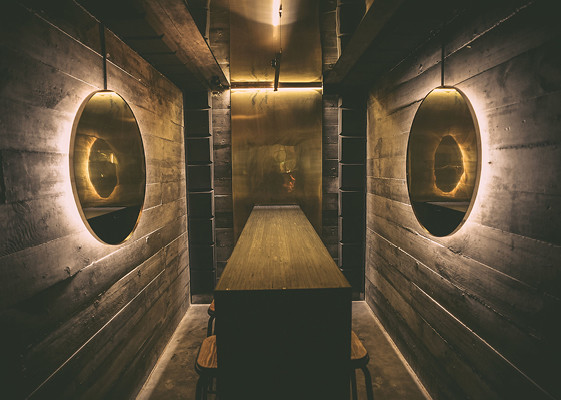
The Fermentist fitout in association with Joska & Sons
So yeah, that’s it in a nutshell!
Regards to best client / commission, I guess it’s like when all the factors come together and, without sounding cheesy, all parts of the orchestra are playing in tune. The relationship of client and architect is critical, but the environment also plays a huge role in what the project is going to look / feel like. Every site has it’s challenges, and it’s often the most challenging that create the best outcomes. I like to set up a series of overarching rules based on the environmental factors, overlaid with any site restrictions set about by planning, along with a strong base structural grid system, then try and bend and stretch them to their breaking point to really test the whole system.
The most rewarding client is an engaged one that likes the process of design. We don’t dictate to our clients, but tease out their wants and needs through the design process. I have had a rather disengaged client with a massive budget before, and found that quite disorientating as I wasn’t really sure if they really liked what we were doing. We did design a bowling alley underneath a 10 car parking platform on Whitewash Head for him though!
We also designed a building totally based around process. It’s a St John Ambulance Hub just up from us on St Asaph Street. The whole building was designed around the process of cleaning and restocking ambulance, from decontamination and sluice systems to restocking and drug control, all through picking up the critical process actions from user groups. We even set up mock rooms and spaces so the users could test the system before building. Seeing that building then work through further Christchurch crises such as the Mosque Attacks has been really rewarding.
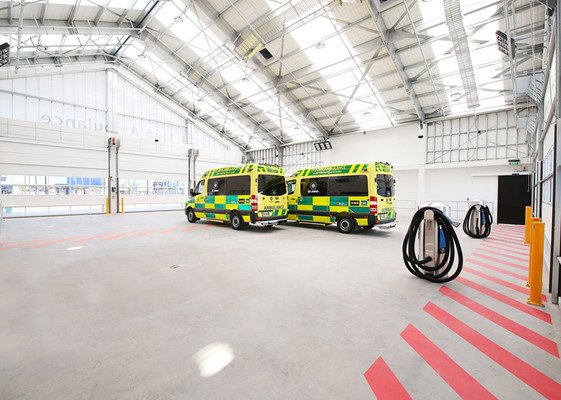
St John Ambulance Hub
4_Andy to Stephen
I’ll dig into your background later but for now you mentioned earlier your All Right? campaign. I love that we have really interactive parts of that particular campaign lying around the house. Interactivity seems to be a common theme through your work.
Is that intentional and a typical part of your design solutions? That just made me think of the dog poo initiative as well! Maybe you could throw some light on that one too??
Oh man - thought everyone had forgotten about that. I really thought it was going to make me millions. Idiot. To explain- I came up with an idea to put biodegradable orange markers into dog turds that encouraged people to pick up their dog crap and called them poo-pins. Somehow I raised $4k USD - didn’t make the target and it slipped into obscurity. The Crazy thing was - the Kickstarter promo got about 400 views and this internet guy - idubbz - who is some kind of internet sensation who mocks kickstarter projects he hates has got two million views - all taking the piss out of me. You can watch it here Funny thing was he’s right on about everything. I had to stop that tangent when an old lady who had seen me on a stuff story said - "aren’t you the poo man" in the street. But yes - interactivity is key for me.
I feel if design can't move you, or make you feel something then it hasn’t done anything and what’s the point of putting it into the world. It can be simply to appreciate that it looks nice, and the design is pleasing and beautiful, but I feel as designers we have a duty to make our work do more than that.
My work seems to have headed that way if I look back - the Kotahitanga pin project after the mosque attack was a wearable pin and icon you could touch and hold and was important for me to create something tangible and interactive as a talking point.
I’ve also in lockdown created a small free print at home book called my lockdown diary which kids print and fill in to keep a record of these times… it’s blown me away that it’s had 90,000 downloads so far and again helping kids being interactive and getting pens, crayons and pencils out and looking at the world around them.
Parents are sending me pics of how it’s helped from round the world and it was purely a Sunday afternoon, sketch on the iPad in response to this Covid situation. To be honest I tend not to think about the craft of it in those situations and just try to think like a kid and get on their level - how are they seeing this - what kind of design will they want to interact with, who’s the audience here - a 10 year old kid! In saying this, this is one part of our studio and I realise the limitations of my own design ability and not everything within our studio gets put through that same lens.
Last year Matt Kitto who was from Studio South came on board as a partner and creative director at Mccarthy and has really helped take the design in areas on a different tangent. We are quite different in our aesthetic approaches and what I’m not good at, he’s great at with type and craft and I’ve really seen a lot of our work go to a different level and the studio team really relish having a different design perspective. It’s making us better as a studio and I never would have never got there by myself - it’s important not to get yourself into a rut.
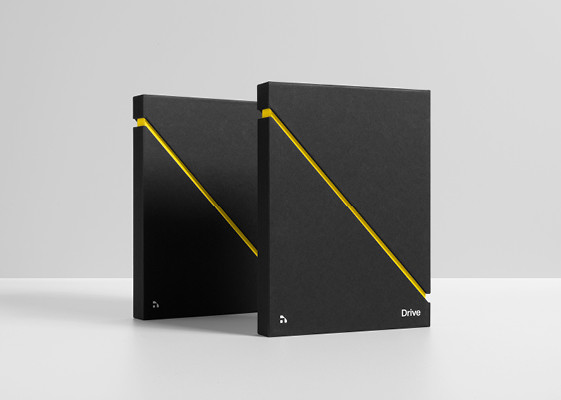
Drive Software brand identity
A big thing for me is I don’t really read design blogs, or study other designers and studios in depth. I feel bit guilty saying that but it’s true. When I see something great randomly, I delve a little deeper and look at work but I find inherently if you are constantly looking at what’s on trend you’ll end up creating just that and you cant help be influenced by the constant scroll of the same, same.
That first seed of a creative idea for me never comes from the computer but more from a random thought while cooking, or staring at a pile of washing - there’s ideas everywhere and the most original ones will come from your own crazy wee head. It’s also important to feel you can share your ideas with your team or workmates and not to be afraid - even its dumb to you or half baked, someone else will usually add to it and make it better down the track.
My most useful creative tool in recent times has been my iPad with the pencil… changed my creative process for the best to sketch, explore and share ideas fast - than people like Matt and the team can actually make it look good and expand on it!
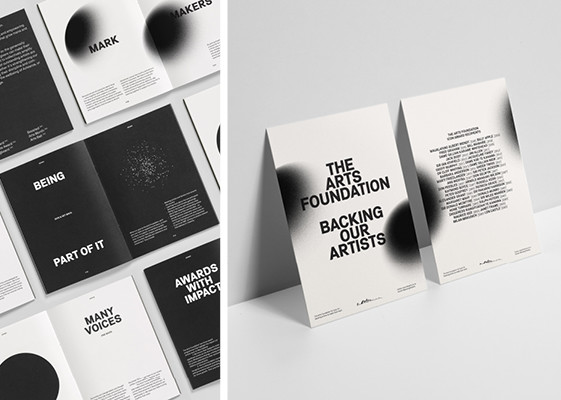
Arts Foundation
5_Stephen to Andy
If a client came to you and said we want you to build our home but you have to live with us for a year so you understand how we live, eat, play, watch tv, and see us get grumpy… would it help make a better home for them?
Would you do it? Would it help?
Brilliant. I’m still wearing the Kotahitanga Pin, thought that was such a great design response to such a shitty situation. We’re also one of the 90,000 downloads but sadly the kids have not been quite as creative.
OK, let's imagine living with a client, and not my Mum (who has now been a client twice - thanks Mum). It’s kind of like what you were saying earlier about not reading too much or scrolling magazines and websites for inspiration.
I find inspirational things arrive when they need to, and that may be via an Instagram image, but I typically wouldn’t chase it. I think living with someone and basing a design around that could be a great experiment, but not necessarily a great design outcome.
Again it goes back to the Big Idea and how you progress that. If the BFI is a design process that involved living and documenting every action that will lead to an informed design, with willing participants, then hell yes I’m all for it. It would kind of be like a Big Brother Architectural experiment. Maybe we could have some cameras and a panel of Architects and Designers further testing us as well.

It does however run the risk of over saturation of information. As a designer I guess I bring my own life experiences and influences to the drawing board, so if the project is essentially a documentation of a daily dairy of a clients life, I’d become more of a biographer where my influence becomes less apparent and the freshness of any ideas may get washed away.
Like any experiment though, it could also create a deeply ingrained and woven together story of how a client lives their life. We might end up with a washing machine in the master bedroom.
Who knows!
6_Andy to Stephen
So I know you have a past history of being in bands and creating music, as well as a jealousy inducing love for traveling to see bands.
Tell me about some of your best memories around making and experiencing music.
Does music form part of your daily design practice or is it an external influence?
Yeah the music side played a big part of life and lots of influences there. I guess in the 90’s the design I was influenced by was David Carson, Frost and a lot of the early Flying Nun work by Chris Knox, David Kilgour, Alec Bathgate and co. It just seemed to be fresh and rebellious with a real unpolished DIY vibe and design that came from the heart.
I think it helped spawn more of a unique and original identity for the New Zealand music Scene and the design at that stage. It would be a great experiment if we took away computers for a year - like they just disappeared in a huge rapture and see what the design started to look like… can we make that happen?
I was in a band called Pine on Arch Hill Records at the time and myself and Aaron Beehre ( who is now a lecturer at Canterbury University in Fine Arts ) were responsible for a lot of the bands artwork and album and poster covers as well as all our own promotional stuff.

Top left: Arch Hill records logotype. Bottom Left. Bands.co.nz website from 2002. Right. Pine - Aaron, Stephen, Hannah
When I look back it’s definitely from a time and era! I also started a website called www.bands.co.nz as I wanted to learn about the web side of design and web was really in its infancy - no youtube, webfonts, instagram or facebook - just photoshop 3 with no layers (yes no layers) and dreamweaver.
I was getting up at 5:30 every morning before work, doing interviews, designing the site, putting up articles and forgetting how to spellcheck. I seriously did not have a clue what I was doing and it looks pretty bad when I look back but again I think it’s about just doing - things don’t have to be perfect - if you strive for perfection every time you’ll never do anything.
Although in one respect it was ahead of its time as we were the first site in New Zealand to offer digital downloads of full albums…. I think we had about 10 up and literally we had four downloads of albums - it was a tad too soon - not done well and a site at the time called mp3.net.nz and nzmusic.com came along and did it much better.
Music in the studio is an interesting one too - with different generations and different tastes it can get a little hectic and it’s about being respectful to all. It’s good though, you have to be open - without the team in the studio I wouldn’t have heard half the music I have and it’s not all to my taste but inspiration comes to different people in different ways and like design - if you’re not open to it and don't embrace different ideas - before you know it, you’re an old guy stuck in 1993 wearing black every day.
Nothing wrong with the 90’s though and highlight of last year was my wife and I going on a cruise ship music festival in Barcelona called the Boaty Weekender - 20 bands play but a fave band of mine is Belle and Sebastian. Other bands were Mogwai, Teenage Fan Club, Yo La Tengo, Django Django, Camera Obscura and it was amazing - although would not want to be on a cruise ship with the past three months situation. Interestingly on the boat I had a chat with Yo la Tengo - and their biggest influence musically was The Clean from Dunedin.
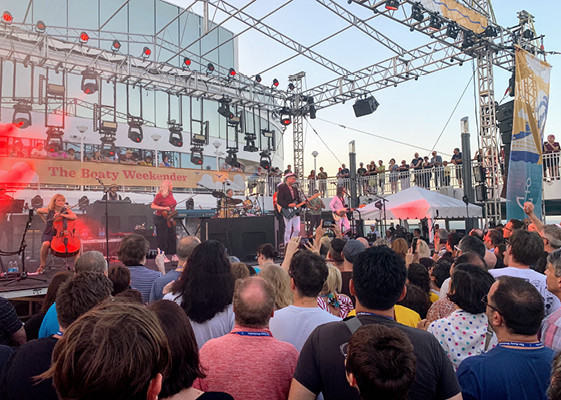
Boaty Weekender, 20 bands on a cruise ship in Barcelona. Belle and Sebastian
The ethos, and the design and the sound that we forged here in the early 80’s influenced a global sound of music to the likes of them and pavement etc. It’s a full circle and I think that’s the power of original thinking in design and music - that scene, that ethos, that design aesthetic shaped music from around the world.
We have to follow our own individual flavour and quirks within design and lead by that. In lockdown though I’ve tried a different tact - I’ve been a bit sick of the voices and styles I usually go to (apart from the Sleaford Mods) and for the past two weeks I’ve actually just played classical music while I’ve been working.
It’s amazing when you listen how the melodies and arrangements of the time are still very relevant today.
7_Stephen to Andy
Back to lockdown and last few weeks as we are about to head to level 3 - what immediate things will you change within the business if any?
People always say when they go to a concert or have an amazing holiday that life is going to change from here on out - but we all soon forget and settle back into how we were before. I think it’s human nature. Do you think this experience will change your work, the way you design, the projects you take on, your work hours and balance and if you could take one New World resolution from this time into your work what would it be?
Indeed, Threedom as they say! It’s now two days after Threedom (sorry have been slack getting back) and I can confirm I have not lined up at Macca's to pollute my pristine home cooked infused temple. I’m not going to say I wasn’t tempted, and may even admit to maybe sitting in a drive through lane for a minute before I realised an hours wait was really not worth the hassle and fleeting feeling of satisfaction.
I guess that becomes a bit of a metaphor for what we have had a chance to learn over the last few weeks. A forced rethink of what our priorities are, a chance to really slow down and sync with the basic rhythms of life. We have added a swathe of new recipes to our family toolbox, and the simple pleasure of cooking has been a real eye opener for me. Having the time to shop, prepare, cook and enjoy in slow mo has been fabulous, and I will miss it dearly as things ramp up again.
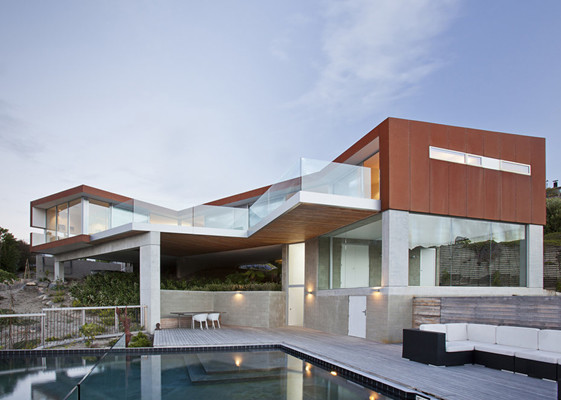
JM lane, Christchurch
The best laid plans will undoubtably be washed away in the excitement of full scale freedom (think gym memberships post NYE) but I do hope there will be a long term pivot (such a now word) towards a ‘slower' way of doing business, where the immediacy of technology has allowed the day to day mundane aspects of running a business and associated jobs to interfere at all hours of the day.
Currently, the only time I can can legitimately go dark is for two weeks at Christmas time. That is really unhealthy and for the last few years, by the time I’ve got to that break i’m a dribbling mess, and probably not being particularly productive / creative. That’s partly my fault, I could pull back and be better at managing my time, but the pace of connection has got out of hand.
I suspect we’ll be paying top dollar for digital free holidays in unconnected wilderness spots (or underground bunkers) in the near future.
So what immediate thing will I change in the business? To be honest likely not a lot. We’ll react to what comes out of this fluid situation. We are a nimble wee practice, and we’ve set up to be able to ride the tides up and down. The main thing for me is to keep our strong team together so we can take the opportunities of what comes next.
I do think that the collective experience we’ve all had will have had an impact in ways that we won’t really understand for years to come.
I took my daughter shopping with me (I know so naughty) but I wanted her to see the line up at New World, with the hand sanitiser and the 2m line markings. I asked her if she’d remember that moment and she said absolutely she would. It’s quite a strong image with all that black and yellow everywhere!! I’d like to think that the big slow down will have a material impact on how we all work.
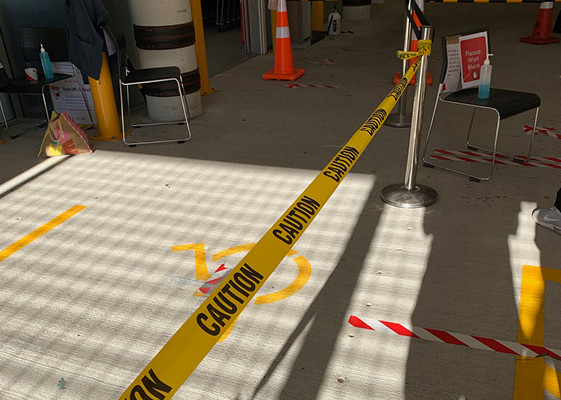
New World Redcliffs
Having space and time to consider all aspects of a commission is a real luxury, and I think we (I mean we as in AWA) often times fall into the trap of cranking through the concept stage too quickly.
I love the studios that get stuck into making models and outlaying a rigorous (maybe sometimes post rationalised?) concept storyline. It’s a fine balance between commerce and creativity though.
So, my takeaway, I’m going to commit to spending more time in the making and baking of the concept (you can hold that to me team AWA, can’t let the other studios have all the sexy models).
And what is to be this Brave New World? Hopefully not a Huxley dystopian future, where anyone different is confined to a lonely existence amongst a homogenous society.
Hopefully our collective experience will generate new areas of creativity and entrepreneurship.
I believe we have a remarkable opportunity now in New Zealand to face the world with shoulders back and quietly invite the lens of 8 billion to have a look at what we can do as a bunch of awesome creative free thinkers in a bubble of 5 million.
So my New World Resolution will be to keep looking out for those opportunities that tend to arise when you have your eyes wide open and you’ve created some space and time around yourself.
8_Andy to Stephen
I’ve really enjoyed this chat over the past week Steve, it’s sometimes not until you sit down and consider a response that it helps galvanise your thinking as well.
I’m going to bat back a similar question, and ask how you feel this experience has affected / impacted / influenced your business, and what will be your one New World resolution?
I come back to the changing phases of all this. It’s now middle of the week in level 3 and I can see thinking and changing moving into a new phase already.
It feels there’s a glut of Covid related posts, influences, thoughts, and ideas out there and as human nature I think we’re all getting a bit overrun with these messages and switching off.
Three weeks ago, it seemed important to be thinking about the immediate but now it’s into the future with our clients and projects and we have to think further ahead - how can we help our clients and our community use design to help benefit their new adapted business, the new normality and not get tainted with a Covid brush on everything.
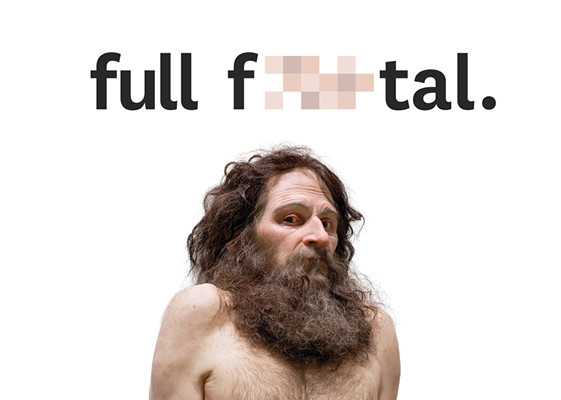
Ron Mueck Campaign
In talking with the team they are itching to get back into the studio, so ideas at the right stage of collaboration can be worked on more effectively.
I’m sure it’s more that they miss me playing Belle and Sebastian back to back. Also means I’ll have to give up the coffee grinder I stole from work...
One thing I never want to see again though is… images on Instagram of zoom meeting screens with people waving.
When the opportunity arises, DINZ interviews leading designers from here and overseas. These interviews seek to dig beneath the surface to address the common and uncommon challenges, problems and opportunities the design community faces.
DINZ Interview with - Logick Print, Marx Design & Thinking Packaging
DINZ Partner Interview - What Does Motor Racing & Printing Have in Common !
DINZ Partner Interview - a Concorde, a Bet & a Million Dollar Deal